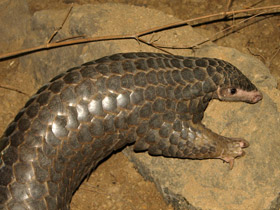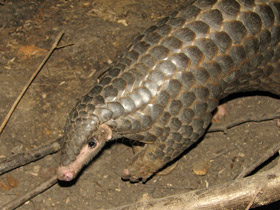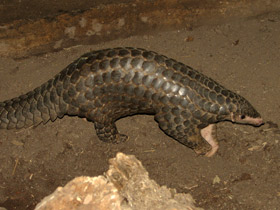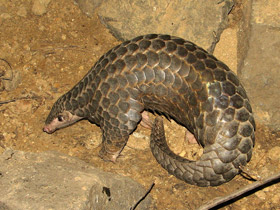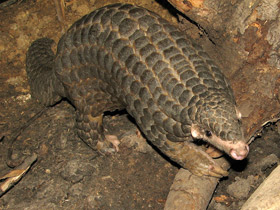The Chinese pangolin (Manis pentadactyla)
The Chinese pangolin (Manis pentadactyla) is a pangolin native to the northern Indian subcontinent, northern parts of Southeast Asia and southern China. It has been listed as Critically Endangered on the IUCN Red List since 2014, as the wild population is estimated to have declined by more than 80% in three pangolin generations, equal to 21 years. It is threatened by poaching for the illegal wildlife trade.
Taxonomy
Manis pentadactyla was the scientific name proposed by Carl Linnaeus in 1758 for the Chinese pangolin. In the 19th century and 20th centuries, several Chinese pangolin specimens were collected and described:
- Manis pentadactyla auritus (by Brian Houghton Hodgson in 1836) from mainland Asia.
- Manis pentadactyla pentadactyla (by Linnaeus in 1758) from Taiwan.
- Manis pentadactyla pusilla (by Joel Asaph Allen in 1906) from Hainan.
Description and habitat area
Manis pentadactyla is a species of folid mammal of the family Manidae. The body length of Manis pentadactyla is about 60 cm, along with a tail length of 18 cm. These lizards have about 18 rows of scales, a small, pointed head, a narrow mouth and well-developed ear pinnae. These unusual animals are found in western Nepal, Assam, the eastern Himalayas, Burma and China. They inhabit lush, subtropical forests.
Lifestyle and nutrition
Manis pentadactyla are a burrowing species. They use their strong clawed feet to dig burrows up to 8 metres deep. Manis pentadactyla can dig such a hole in 3-5 minutes. Once inside, the lizard closes the entrance to the burrow. Relatively little is known about the life of the Manis pentadactyla, as this animal is nocturnal and extremely shy. When attacked by a predator, the Manis pentadactyla curls into a ball. Like other pangolins, it feeds on ants and termites. With their powerful claws, they destroy the homes of these insects before grabbing them with their long (up to 25 cm) and sticky tongue.
Reproduction
Manis pentadactyla gives birth in April or May. A single brood of about 45 cm in length is born. The young are born with scales, although the first two days of life the pups are still very weak. Although the pups can move immediately after birth, the female carries them on her tail or on her back. The males also show their parental instincts well and share their den with the female and her cubs.
Conservation status
Manis pentadactyla is included in the IUCN Red List with the status of endangered species. The main reason for the decline of these animals is hunting for meat and habitat destruction due to land development.
Threats
The Chinese pangolin is threatened foremost by poaching. Some Chinese people eat its meat, and its scales are used as an ingredient in traditional Chinese medicine (TCM). In the 1960s, about 170,000 to 180,000 Chinese pangolins were seized annually across the Chinese provinces Fujian, Hunan, Guangxi, Guizhou, Yunnan and Guangdong. The Convention on International Trade in Endangered Species in 2002 prohibited selling pangolins across national borders. Although China has already passed laws to protect the pangolin, it might not be enough to save the species. The Convention on International Trade in Endangered Species of Wild Fauna and Flora reports that pangolins are the most trafficked and poached mammal.
Chinese pangolin scales are sold to treat a wide variety of ailments, from cancer to upset stomach to asthma. Other pangolin body parts are also used in traditional Chinese medicine. 71% of the TCM practitioners interviewed in a 2020 study believed that pangolin scales could be substituted by other ingredients "in at least some, if not all, treatments". Local people in eastern Nepal consider pangolin scales as good-luck charms.

















